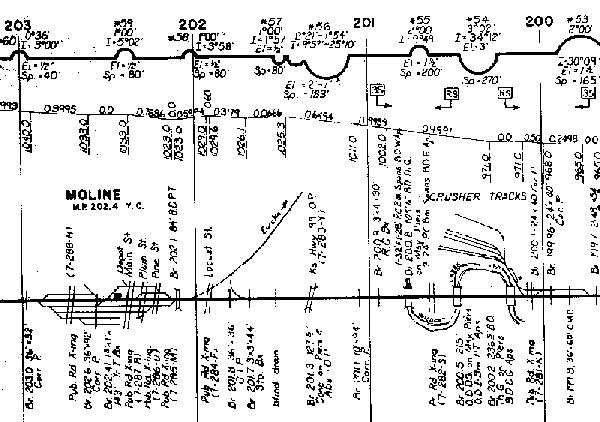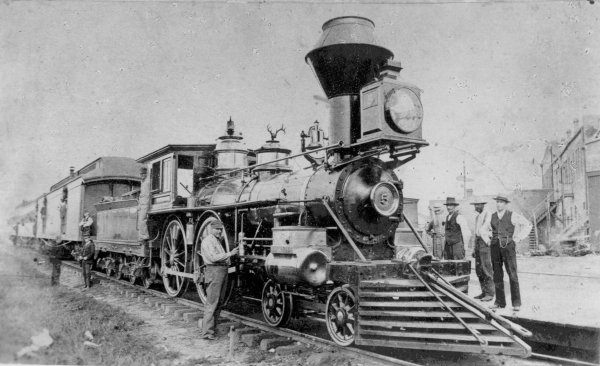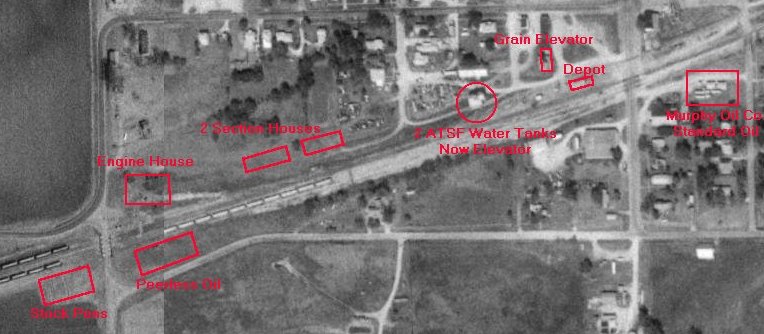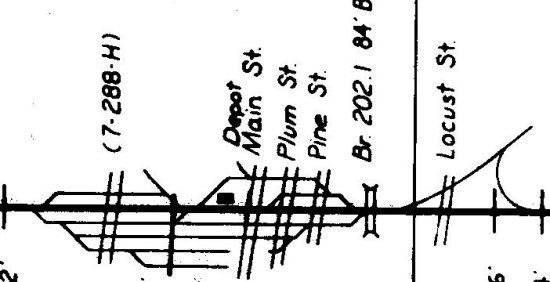Howard Branch: MolineUpdated 10/30/03 |
|
The first train arrived in Moline on the Howard Branch in 1879.
Moline was the end of the line, or maybe it would be better to say the beginning of the line. From the early 50s when the 95/96 started running on alternate days, crews on the Howard District worked out of Moline. That was one factor in explaining the difficulty the railroad often had in getting crews to desire this assignment. The Howard Branch entered through a wye on the east side of town. The main business of the area and a creator of much traffic was the limestone quarry known as "Crusher" to the railroad and Solvay to the locals. Of course the Howard had the least traffic. The line from Chanute to Winfield for Wellington and Newton was by far more significant and much of it remains today as the South Kansas and Oklahoma Railroad. The author ran across an SKOL freight here on Nov. 11, 2002. It had four units on the front followed by 83 cars: CEBX 100 Schnobel, 47 covered hoppers, 24 tanks, 8 boxes, 2 open hoppers, and 1 bulkhead flat.
"Moline Kansas at the south end of the Howard Branch was a busy little railroad town on the Southern Kansas Division's second district. The Howard Branch train often pulled in alongside the westbound second district local which worked Chanute to Winfield through Fredonia toward Wellington. I was frequently in town at noon. A "through freight" ran each way by night between Chanute and Wellington thru Independence and the Elk River Valley below Longton. A "doodlebug" passenger train each way each day tied remote Coffeyville to Wichita and Newton and paused in its passing at Moline for cream cans, mail, and an occasional passenger."
"West of the depot stood a two stall engine house where lived the Moline Helper." No photos of this "roundhouse" have been found, and it was gone by 1960. The highway turn at that location is still known as the "roundhouse corner." "Most westbound freights needed help to get up the Flint Hills grade to Grand Summit - even the short legged 1667 (2-10-2) - typical power for the rock train. She'd come down the hill alone in the evening with miscellaneous merchandise and "MTs" (empties). (Grand Summit was 15 miles west. There was a continuous 1.5% grade for 4.5 miles leading to the crest.) "In addition to the regular 2nd District trains, there was a 6 day a week rock train which worked the crusher and round tripped to Winfield. It's regular power during my time (1947-52) was the 1667. There were also frequent extras on this line and occasional mainline detours from Ottawa to Wellington." "For years the 3102 (2-8-2) was the Moline Helper, helping several westbound freights each day up the Flint Hills from Moline to Grand Summit. In this service she was equipped with a small low tender adequate for her relatively short runs and providing good back up visibility. She routinely returned rear first to Moline and though there was a wye at the top of the hill, there was no turntable at Moline, and the wye there was inconveniently out east." "She shared the two stall Moline engine house with the Howard Branch engine and so was conveniently available to make the run to Emporia in case the branch engine woke up sick. Westbounds would simply set out tonnage. She'd take it to Winfield when she got back. She was also ready to grab a caboose and run up the branch to load cattle as an extra when the local was too busy." James Burke The engine house was corragated metal and had no windows. Locomotives primarily received their oil at Winfield, Emporia, or Chanute. For example, 95-96 would be serviced in Emporia and have sufficient oil to make the round trip to Moline. However, a company tank car was parked on the track by the engine house (track 6) and was used as when the engines were running low. Water for the Howard Branch was available at Moline, Eureka, Madison, and Emporia. Between the engine house and the water tanks were two brick non-standard section houses for Santa Fe workers. There was no city street to the section houses; workers had to use the right-of-way to get home. In the 1921 photo above, those houses had not been built but 5 box cars had been converted into housing. Sanborn maps reveal an evolution of track plans in Moline. The 1898 map shows a coal bin east of the depot and an open stock yard across the tracks from it. The depot has always stood just west of Main St. The elevator was the Frank Webb Grain Warehouse and Feed Mill, but had no spur to serve it. The map of 1901 shows a water tank between the main and a siding plus a series of coal bins served by an incline trestle. Moline Canning was shown across from the depot abut was not in operation. By 1908, the coal bin east of the depot was gone, but the stock yard remained. Moline Canning had become Moline Ice Company. The water tank and coal bins between the tracks remained, but a second water tank is shown where two would eventually be located north of the coaling tower. The elevator was now the F. W. Webb Feed Mill and had its own spur. A Wells Fargo Express building was added on the platform just west of the depot. The 1915 map shows the addition of an electric light plant north of the tracks on Main St. which included a buried fuel oil tank. The stock yard was now gone. Kansas Co-operatiave Oil Company had installed 4 tanks just west of Moline Ice. The coal tower and testle had been replaced by a coal chute which stradled a relocated siding (see photo) and the current two iron water tanks replaced the two tanks of 1908. The elevator was now known as Webb & Walker's Feed Mill and had a coal shed on the Webb spur. For 1927, the last Sanborn map located, the light company was gone. Between Main and Plum three bulk oil dealers had been built: Continental, Standard, and Peerless. The Co-Op Oil and Moline Ice were gone. The Coaling and water facilities remained, but the new elevator is shown labeled as Farmer's Mill and Elevator. A new coal shed adjoined the elevator right beside the Webb spur. The CLIC map for 1985 is linked. Moline had 1200 inhabitants in 1950. In 2000, Moline it had dwindled to 473 residents. |













